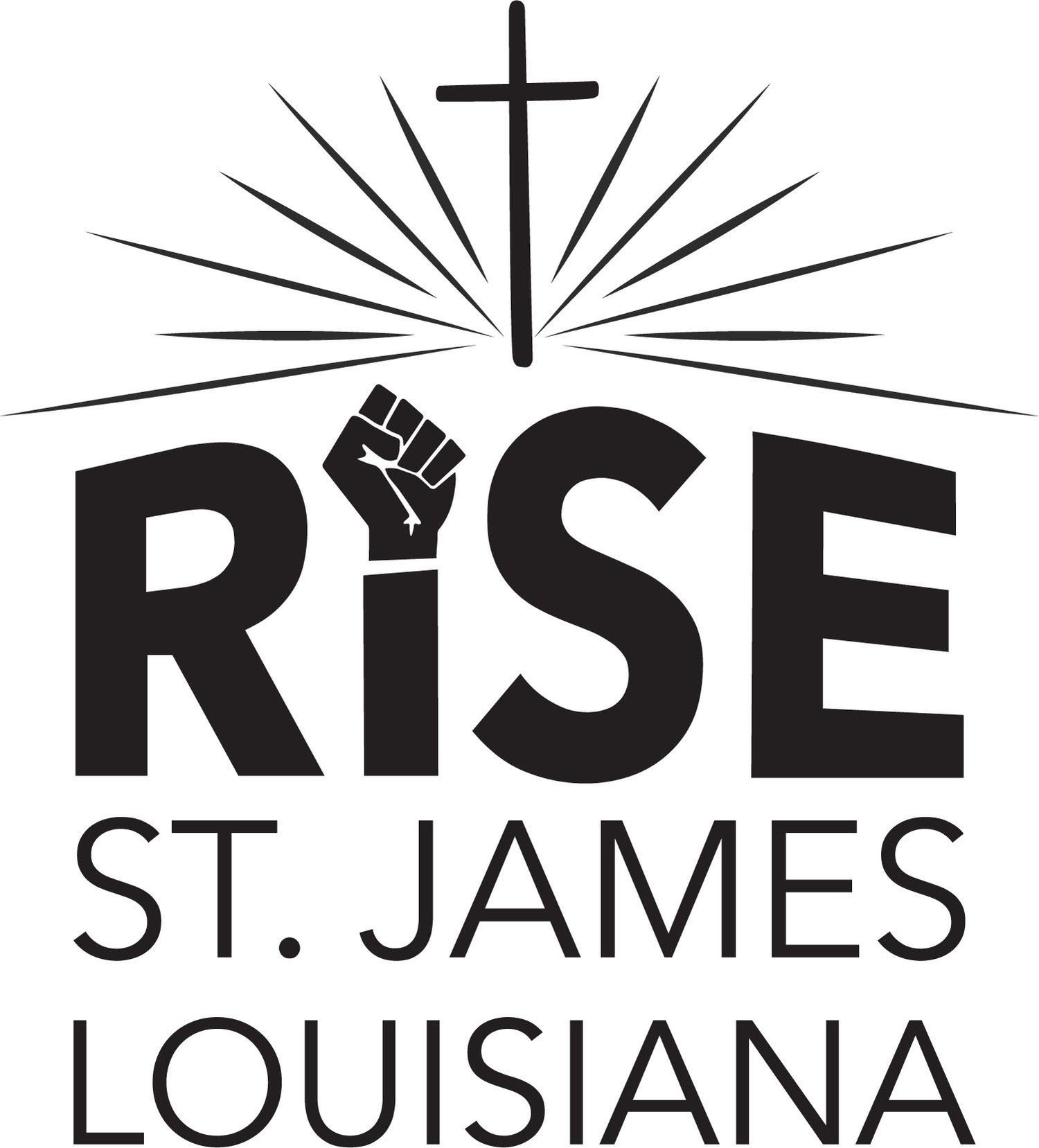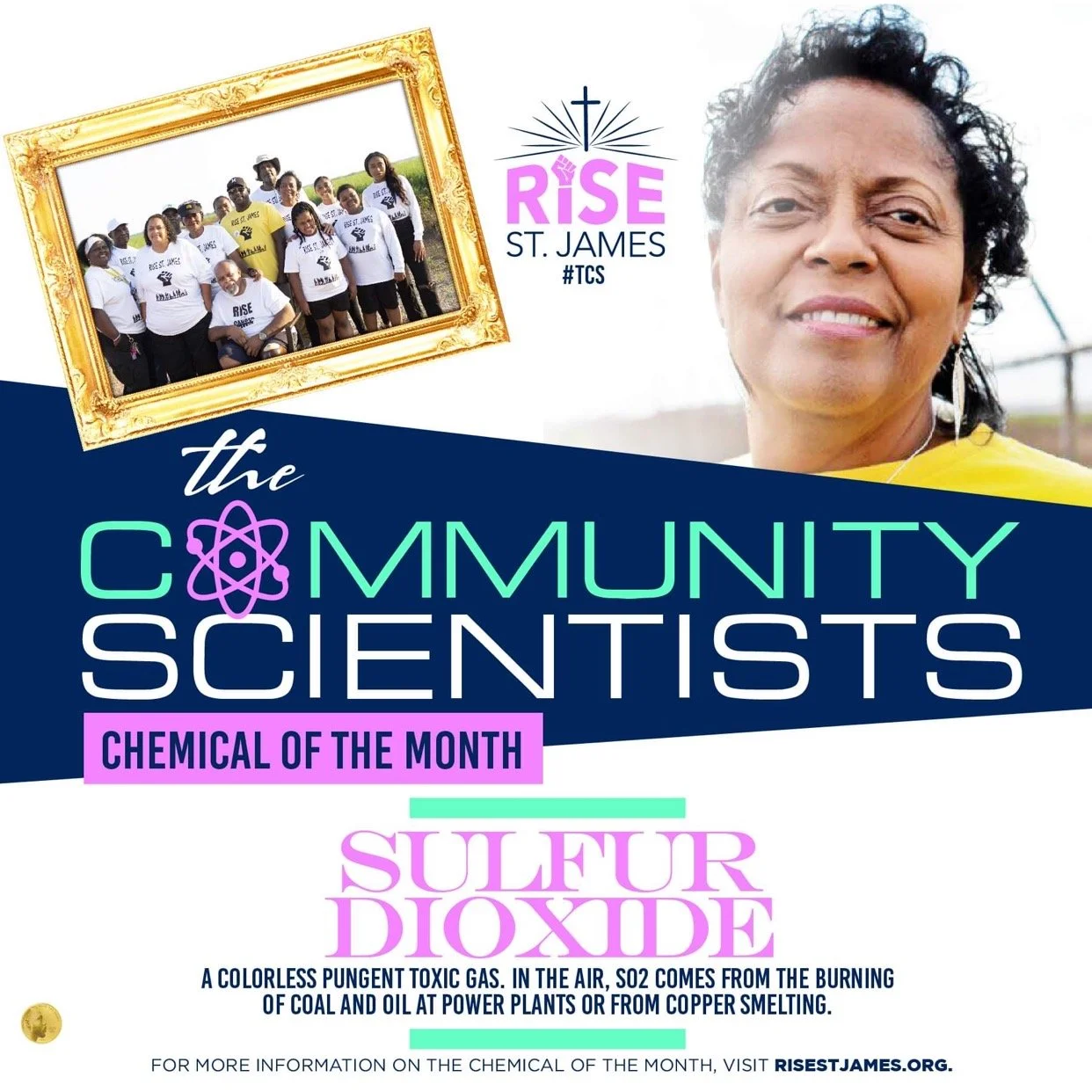Sulfur Dioxide - Chemical of the Month, December 2022
CHEMICAL OF THE MONTH - Sulfur Dioxide
A service program of RISE St. James; Caitlion O. Hunter, Juris Doctor, Class of 2022, Past President, Loyola Environmental Law Society; Tim Schütz, PhD Researcher, Anthropology University of California, Irvine; and The Community Scientist (TCS) Research Team
Editor’s Note: As we enter our fourth monthly series on chemicals, we will be focusing on pollutants that you can sense. Many chemicals, including ethylene oxide, are colorless and odorless, and it can be difficult to even know about exposure until cancer, asthma, or other health effects develop. Our first three chemicals were also those that the proposed Formosa Plastics plant was permitted to emit. These next three chemicals, starting with sulfur dioxide, make their presence known through odor, color, and even taste. The Community Scientists will be broadening our scope to other environmental justice communities around the state over the next three months of this series.
In some ways, sulfur dioxide is an environmental success story. The Clean Air Act, which was passed in 1970 and strengthened in 1977 and 1990, established the National Ambient Air Quality Standards and required polluters to use technology to lower their emissions of sulfur dioxide and other pollutants. As a result, the average level of sulfur dioxide has decreased by 94% in the U.S. over the last two decades. Most of this improvement came from shutting down coal-fired power plants and using new technology to lower emissions from the remaining plants. While the average American is no longer exposed to harmful or even noticeable levels of sulfur dioxide, environmental justice communities still struggle with sulfur dioxide emissions from coal-fired power, petrochemical refineries, and coke plants.
Sulfur dioxide is one of six chemicals that are classified as “criteria pollutants” by the Clean Air Act. These are common pollutants that are harmful to human health and environmental quality. Because criteria pollutants are common and harmful, the Environmental Protection Agency (EPA) has limited the amount of these pollutants that can be present in the air. These limits are known as National Ambient Air Quality Standards, or NAAQS. (“Ambient” means outdoor.) Although these criteria pollutants are highly regulated, it can still be difficult to confront polluters who are violating their permits. For most criteria pollutants, including sulfur dioxide, it takes three years of data collection to determine whether the standard is being violated. Instead of a quick call to the EPA or state environmental agency, advocates need to spend their time and money monitoring emissions from a suspected violator.
Ideally, there would be limits on the amount of all harmful chemicals (i.e., pollutants) in the air. But this is a big challenge, because each pollutant is unique in terms of how long it remains in the air, how long it takes to break down, which part(s) of the body it damages, and how that damage occurs. What’s more, all of these factors can be affected by interactions with other chemicals that might be present. Many scientists believe that, because of this complexity, environmental regulators usually underestimate the health risks from air pollution. In fact, one of the greatest breakthroughs in RISE’s recent court victory over Formosa Plastics and LDEQ was a requirement that LDEQ conduct a cumulative impact assessment. This means that LDEQ must now consider the existing pollutants in the air when issuing future permits for the proposed Formosa Plastics plant.
Like most pollutants, sulfur dioxide can cause asthma, lung damage, and other respiratory problems. Sulfur dioxide is one of the main causes of acid rain. Sulfur dioxide has a strong smell, and is immediately irritating to the lungs and nose in large enough concentrations. Children with asthma are especially sensitive to sulfur dioxide, and it can trigger asthma attacks. Exposure in childhood can result in asthma or other lifelong respiratory problems. Workers who are exposed to sulfur dioxide on the job can also develop decreased respiration and inflammation of the lungs. Exposure at very high concentrations, such as that from an explosion or accidental release event, can be fatal. And from 2005-2009, sulfur dioxide was the most commonly released chemical during Louisiana refinery accidents.
In St. Bernard Parish, less than seven miles downriver from the French Quarter, clouds of white smoke and vapor billow up from several huge facilities sandwiched between the main road and the river. The smell of rotten eggs or overcooked broccoli is often noticeable at businesses across the street and nearby homes. These odors indicate the presence of sulfur compounds, including sulfur dioxide. During release events, like an April 2020 explosion, the smells can be so strong that people are forced to leave their homes. The effects were also sensed downriver and downwind as a plume of smoke traveled from the refinery.
The EPA recently determined that St. Bernard Parish is out of compliance for sulfur dioxide levels under the NAAQS. The parish has long had a sulfur dioxide problem; of the three largest sulfur dioxide emitting plants, two of them are currently under federal consent agreements for covering up their emissions and emitting beyond their permits. One of these plants, Rain CII Carbon, is currently the main contributor to sulfur dioxide pollution in the area, and has long failed to control its emissions.
Residents of St. James Parish are also still celebrating a victory from September 2018, when Nucor Steel officially canceled its plans to build a Pig Iron Manufacturing Facility that could have released over 30,000 tons per year of sulfur dioxide into the air each year – double the amount released by the largest coal-fired power plant in Louisiana. While most Americans no longer have to worry about the harmful effects of sulfur dioxide, people in Louisiana are still fighting to lower the levels of this harmful pollutant from industrial sources that were built too close to our residential neighborhoods.
Table 1. Reported sulfur dioxide (SO2) emissions per parish in 2019 for the top 10 parish with the highest SO2 emissions; parishes are listed in order of decreasing reported emissions. Source LDEQ ERIC: https://www.deq.louisiana.gov/page/eric-public-reports
Louisiana parish
Reported sulfur dioxide (SO2) emissions (tons) in 2019
Calcasieu 24,896
St. Mary 21,238
East Baton Rouge 12,062
Evangeline 11,043
West Baton Rouge 6,994
Pointe Coupee 6,068
DeSoto 6,013
Rapides 4,984
St. Charles 2,696
St. Bernard 1,915
Figure 1. Point source clusters of reported sulfur dioxide emissions in Louisiana from 2017 National Emissions Inventory (NEI) data. Source: https://gispub.epa.gov/neireport/2017/
In some ways, sulfur dioxide is an environmental success story. The Clean Air Act, which was passed in 1970 and strengthened in 1977 and 1990, established the National Ambient Air Quality Standards and required polluters to use technology to lower their emissions of sulfur dioxide and other pollutants. As a result, the average level of sulfur dioxide has decreased by 94% in the U.S. over the last two decades. Most of this improvement came from shutting down coal-fired power plants and using new technology to lower emissions from the remaining plants. But, like many air quality success stories, not everyone has benefitted equally from these improvements. Today, power plants and industrial facilities remain the largest source of sulfur dioxide emissions, and nearby communities face the same health risks that prompted the passage of the Clean Air Act over 50 years ago. In Louisiana, the largest sources of sulfur dioxide emissions are power plants and coke plants, which are located in parishes across the state, including in Calcasieu, DeSoto, East Baton Rouge, Evangeline, Pointe Coupee, St. Mary, St. James, and West Baton Rouge.

